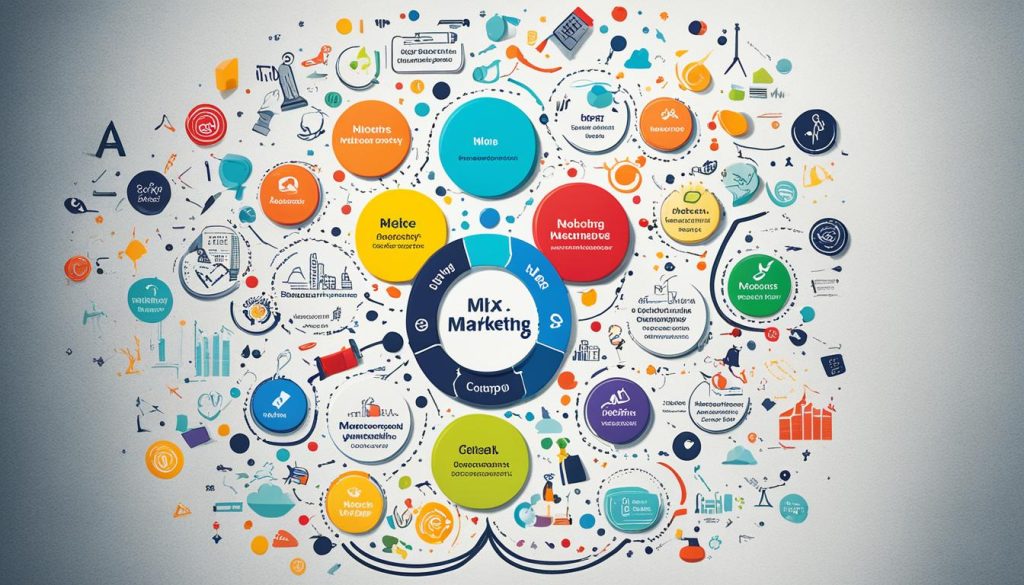Have you ever wondered how companies create successful marketing strategies? It all starts with understanding the marketing mix. The marketing mix, often referred to as the 4Ps, is a crucial framework that helps businesses define their product or service offerings and how they will be promoted and sold to customers.
In this blog post, we’ll explore the concept of the marketing mix in detail. We’ll break down each of the 4Ps – Product, Price, Place, and Promotion – and discuss how they work together to create a cohesive marketing strategy. Whether you’re a business owner looking to refine your marketing approach or a marketing student eager to learn more about the fundamentals, this post will provide you with valuable insights into the world of marketing. Let’s dive in!
What is the Marketing Mix?
The marketing mix is a fundamental concept in the field of business and marketing. It refers to a strategic framework that helps organizations make informed decisions when launching new products or revising existing ones. By considering the four Ps of product, price, placement, and promotion, companies can create a comprehensive marketing plan that effectively meets the needs and wants of their target customers.
Introduced by marketing professor E. Jerome McCarthy in 1960, the marketing mix has become a cornerstone of marketing strategy. It provides a structured approach to understanding and addressing key elements of product development and marketing. The four Ps serve as the foundation, and businesses can also incorporate three additional elements – people, process, and physical evidence – to further enhance their marketing efforts.
The marketing mix plays a crucial role in the success of any business. By carefully considering the product, price, placement, and promotion, companies can effectively communicate the value of their offerings to their target audience. This leads to increased brand awareness, customer engagement, and ultimately, business growth. Moreover, integrating the additional elements of people, process, and physical evidence strengthens the customer-centric approach, ensuring an exceptional customer experience that fosters loyalty and drives repeat business.
What Are the 4 Ps of a Marketing Mix?
The marketing mix is a powerful framework that encompasses the four key elements known as the 4 Ps: product, price, placement, and promotion. Understanding and effectively implementing these elements are crucial for the success of any marketing strategy.
- Product: The product is the core offering that satisfies the needs and wants of the target market. It can be a tangible item or an intangible service. Successful marketers differentiate their product from competitors by emphasizing unique features, benefits, or branding.
- Price: Price determination involves considering both the target market’s willingness to pay and the costs associated with producing and marketing the product. Setting the right price is essential to ensure profitability while remaining competitive in the market.
- Placement: Placement refers to selecting the appropriate distribution channels and locations to make the product easily accessible to the target customers. This includes decisions on whether to sell through wholesalers, retailers, or online platforms, and determining the best physical locations for reaching the target audience.
- Promotion: Promotion encompasses the various marketing activities and communication channels used to create brand awareness and drive sales. It includes advertising, public relations, sales promotions, and personal selling. The goal is to reach the target market effectively, engage them with persuasive messages, and encourage them to take desired actions.
By effectively managing these four Ps, businesses can create a comprehensive marketing mix that aligns with their target market’s needs and wants, successfully differentiates their product, optimizes pricing strategies, ensures widespread product availability, and engages in effective promotional activities.
Let’s further explore each of the four Ps:
Product Differentiation
Product differentiation is a crucial strategy for marketers to set their product apart from competitors. It involves communicating the unique features, benefits, and value proposition of the product. This can be achieved through innovative design, superior quality, or even intangible aspects such as exceptional customer service or user experience.
Pricing Strategy
Pricing strategy involves determining the optimal sale price for a product to maximize profitability while remaining competitive. Marketers consider factors such as production costs, competitor pricing, target market’s willingness to pay, and the perceived value of the product. Pricing decisions can have a significant impact on consumer perceptions and market positioning.
Channel Selection
Channel selection is about choosing the most appropriate distribution channels to make the product available to the target market. Marketers need to understand customer preferences and behaviors to determine whether to sell through wholesalers, retailers, online platforms, or a combination. The aim is to ensure convenient access and efficient distribution to reach the target audience effectively.
Promotional Mix
The promotional mix involves selecting the most suitable marketing communication channels to create brand awareness and stimulate sales. It can include advertising, public relations, sales promotions, and personal selling. Marketers need to consider the target market’s media consumption habits, preferences, and demographics to develop effective promotional campaigns.
The 4 Ps of a marketing mix provide a solid foundation for developing effective marketing strategies. By understanding the interplay between product, price, placement, and promotion, marketers can create a comprehensive plan tailored to their target audience’s needs and preferences. This strategic approach enhances brand visibility, drives customer engagement, and ultimately contributes to business success in the competitive marketplace.
What Are Other Marketing Tools?
While the marketing mix typically revolves around the four Ps – product, price, placement, and promotion – customer service businesses often incorporate additional elements into their marketing strategies to meet their unique needs. These additional tools, including people, process, and physical evidence, play a vital role in enhancing the overall customer experience and driving business growth.
People
One essential marketing tool for customer service businesses is people. The employees who directly interact with customers can significantly impact their perception of the brand. Friendly, knowledgeable, and attentive staff can create positive experiences, build trust, and foster long-term customer loyalty. Investing in training and development programs for employees can help ensure that they embody the brand values and deliver exceptional customer service.
Process
The process is another crucial marketing tool for customer service businesses. It refers to the method of providing service and monitoring customer satisfaction. A streamlined, efficient process can enhance the overall customer experience and improve operational efficiency. By analyzing customer feedback and identifying pain points in the service delivery process, businesses can make necessary improvements to meet customer expectations and ensure smooth interactions.
Physical Evidence
Physical evidence plays a significant role in the marketing efforts of customer service businesses. It pertains to the physical space where customers and company representatives interact, including retail stores, offices, or digital platforms. A visually appealing and well-designed environment can enhance the brand image, create a positive impression, and contribute to a memorable customer experience. Attention to details such as cleanliness, organization, and branding can make a lasting impact on customers.

Customer service businesses also dedicate resources to studying consumers and integrating their preferences and feedback into their marketing strategies. By actively listening to customers, businesses can understand their needs and wants, and tailor their offerings and marketing campaigns accordingly. Effective communication and feedback channels allow businesses to continuously refine and update their strategies to stay relevant in a dynamic market.
| Marketing Tools | Customer Service Businesses |
|---|---|
| People | Employees who interact with customers leave a lasting impression and build customer loyalty. |
| Process | An efficient service delivery process enhances the overall customer experience. |
| Physical Evidence | A visually appealing physical space creates a positive brand image. |
What Are the Four Elements of a Marketing Mix?
The four primary elements of a marketing mix are product, price, placement, and promotion. These elements work together to create a comprehensive plan that distinguishes a product or service from competitors and brings value to the customer.
Product refers to the goods or services that meet customer needs, while price determines the cost and perceived value. Placement involves selecting the distribution channels, and promotion focuses on creating brand awareness and driving sales through various marketing activities.
When developing a marketing strategy, it is crucial to consider each of these elements to ensure a cohesive and effective approach. By carefully crafting the product, determining an appropriate price, selecting the right placement channels, and implementing compelling promotions, businesses can effectively communicate their value proposition and stand out in the market.
| Element | Description |
|---|---|
| Product | The goods or services offered to meet customer needs |
| Price | The cost associated with the product and its perceived value |
| Placement | The selection of distribution channels for reaching the target market |
| Promotion | The marketing activities aimed at creating brand awareness and driving sales |
By carefully considering and implementing each of these four elements, businesses can develop a well-rounded marketing mix that attracts customers, creates brand loyalty, and drives revenue growth.

What Are the 7 Ps in a Marketing Mix?
The marketing mix is a strategic framework that combines various elements to create an effective marketing strategy. While the traditional marketing mix consists of the four Ps – product, price, placement, and promotion – there are three additional elements that can enhance the overall marketing mix strategy. These three additional Ps are people, physical evidence, and process.
People: People play a crucial role in any marketing strategy. They represent the employees who interact with customers and contribute to the overall brand strategy. By having knowledgeable and customer-focused employees, businesses can ensure a positive customer experience and build strong relationships with their target audience.
Physical Evidence: Physical evidence refers to the tangible aspects of the customer experience. It includes the packaging, store layout, signage, and any other elements that customers come into contact with when interacting with a brand. Creating a visually appealing and cohesive physical environment can greatly influence a customer’s perception of a product or service.
Process: Process refers to the logistical and operational procedures involved in delivering a product or service to customers. A seamless and efficient process ensures that customers have a positive experience from start to finish. This can include everything from the ordering process to delivery or service interactions.
By incorporating these additional elements into the marketing mix, businesses can take a more customer-centric approach. These elements address the people, physical environment, and operational processes that directly impact customer satisfaction and loyalty. When combined with the traditional four Ps, the 7 Ps of the marketing mix create a comprehensive strategy that caters to both the needs of the business and its target audience.

| Traditional 4 Ps of Marketing Mix | Additional 3 Ps |
|---|---|
| Product | People |
| Price | Physical Evidence |
| Placement | Process |
| Promotion |
What Is the Purpose of a Marketing Mix?
The purpose of a marketing mix is to promote a product or service and generate revenue for a business. By utilizing the four Ps and other additional elements, a marketing mix creates a comprehensive plan that focuses on building brand awareness, driving sales, and fostering customer loyalty.
The four Ps – product, price, placement, and promotion – are the foundational elements of a marketing mix. They work together to create a strategic approach that effectively communicates the value of a product or service to the target audience.
Product: This element involves developing a quality product or service that satisfies customer needs and wants. It encompasses product design, features, and benefits that differentiate it from competitors. Having a compelling and innovative product is crucial for capturing market share and gaining a competitive edge.
Price: Determining the appropriate price for a product is essential for maximizing profitability and generating business revenue. Marketers need to consider factors such as production costs, competition, and customer value perception when setting the price. The right pricing strategy can help attract customers and establish a strong market position.
Placement: Selecting the right distribution channels to make the product available to customers is crucial for its success. Marketers need to identify the most effective channels that reach the target audience and make the product easily accessible. From traditional retail stores to e-commerce platforms, the placement strategy plays a significant role in reaching customers efficiently.
Promotion: This aspect focuses on creating brand awareness and influencing consumer behavior. Marketers use various promotional techniques such as advertising, public relations, sales promotions, and social media marketing to communicate the product’s value proposition effectively. An effective promotion strategy helps generate customer interest, boost sales, and build a loyal customer base.
In addition to the four Ps, other elements such as people, physical evidence, and process can be integrated into the marketing mix to reinforce a customer-centric approach.
People: The employees who interact with customers play a crucial role in shaping the customer experience. From sales associates to customer service representatives, having well-trained and customer-focused staff can enhance brand perception and loyalty.
Physical Evidence: The physical environment in which customers interact with the product or service can influence their perception and satisfaction. Attention to factors such as store layout, design, packaging, and overall ambiance can create a positive brand experience.
Process: The processes and procedures involved in delivering the product or service contribute to customer satisfaction. Streamlining processes, providing efficient service, and ensuring a smooth customer journey are essential for building trust and loyalty.
A well-executed marketing mix helps businesses effectively meet customer needs and wants, which ultimately leads to increased business revenue, enhanced brand awareness, and improved customer loyalty. By consistently evaluating and optimizing the marketing mix, businesses can adapt to changing market dynamics, stay competitive, and achieve their marketing goals.
| Benefits of an Effective Marketing Mix | Examples |
|---|---|
| Increased brand awareness | Global brands like Coca-Cola and Nike have effectively conveyed their brand message through strategic marketing campaigns, resulting in high brand recognition and recall. |
| Higher business revenue | Apple’s strategic pricing and distribution strategies have contributed to its significant revenue growth over the years. |
| Customer loyalty and advocacy | Starbucks’ focus on providing a unique customer experience with personalized service and loyalty programs has fostered a loyal customer base that advocates for the brand. |

Conclusion
In conclusion, businesses must understand and implement the marketing mix to thrive in a competitive market. The four essential elements – product, price, placement, and promotion – lay the groundwork for a comprehensive marketing plan. By incorporating additional elements such as people, physical evidence, and process, marketers can develop customer-centric strategies that enhance brand awareness, drive sales, and foster customer loyalty.
A well-executed marketing mix plays a crucial role in optimizing businesses’ marketing efforts and achieving their goals in today’s dynamic business landscape. It helps organizations effectively communicate the value of their products or services to their target audience and make informed decisions that meet customer needs and wants.
Understanding the importance of marketing strategy is key for businesses looking to create a strong brand presence and generate revenue. By carefully analyzing and implementing a well-rounded marketing mix, businesses can position themselves for success and gain a competitive edge in their industry.





